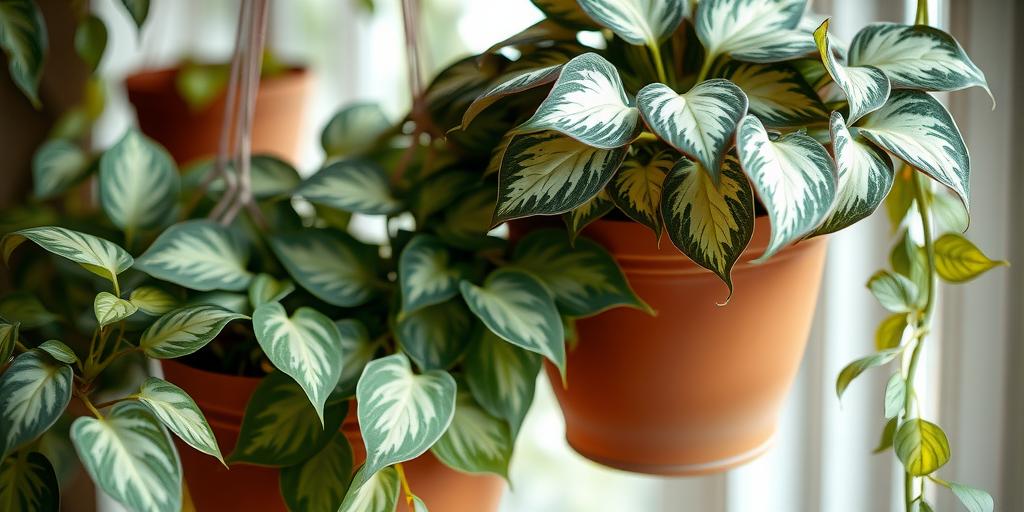
Stunning Variegated Hanging Plants That Thrive in Low Light
Discover the best variegated hanging plants that flourish in low-light conditions! Perfect for brightening up dim corners with vibrant foliage—no direct sunlight needed.
Introduction
Did you know that some of the most eye-catching houseplants actually prefer low light? Variegated hanging plants bring a splash of color and texture to any space, even in areas with minimal sunlight. Whether you’re sprucing up a shady balcony, a dim hallway, or a cozy bathroom, these trailing beauties are the perfect solution. In this guide, we’ll explore the top variegated hanging plants that thrive in low light, along with care tips to keep them lush and vibrant. Let’s dive in!
The Unique Appeal of Variegated Foliage in Dim Spaces
Variegated hanging plants bring a splash of color and texture to low-light corners where many other plants might struggle. Their patterned leaves—whether streaked, marbled, or edged in contrasting hues—reflect what little light is available, making them appear brighter than solid-green varieties. This makes them perfect for rooms with north-facing windows or spaces far from natural light sources. The dynamic foliage also adds visual interest, breaking up the monotony of darker areas in your home.
How Low-Light Plants Adapt to Indoor Conditions
Plants that thrive in low light have evolved to make the most of minimal sunlight. Many variegated species, like pothos and philodendrons, originate from forest floors where they receive dappled sunlight through dense canopies. Their leaves often have larger surface areas to capture more light, and some develop thinner leaves to allow light to penetrate deeper. While variegation can sometimes mean less chlorophyll (which plants use for photosynthesis), the varieties recommended here have just enough to sustain growth even in dimmer settings.
Benefits of Hanging Plants for Small Spaces and Air Purification
Hanging plants are a game-changer for small apartments or rooms with limited floor space. By elevating them, you free up surfaces while still enjoying the greenery. Many variegated hanging plants, like spider plants and pothos, are also known for their air-purifying qualities. They help filter out common indoor pollutants like formaldehyde and benzene, making your space not only prettier but healthier too.
Top Variegated Hanging Plants for Low Light
1. Variegated Pothos (Epipremnum aureum ‘Marble Queen’)
If you’re looking for a plant that’s nearly impossible to kill, the Marble Queen Pothos is a top contender. Its creamy white and green marbled leaves brighten up any dim corner, and it thrives in indirect light—though it can tolerate lower light levels too. This plant is forgiving if you forget to water it occasionally, making it perfect for beginners. Let the soil dry out between waterings, and it will reward you with long, trailing vines that can grow several feet long.
2. Philodendron Brasil (Philodendron hederaceum ‘Brasil’)
The Philodendron Brasil is a showstopper with its heart-shaped leaves splashed in lime green and golden yellow. It grows quickly, filling out a hanging basket in no time, and adapts well to low-light conditions. Unlike some finicky plants, this one is happy as long as it’s not sitting in direct sun. It’s also a great choice if you love the look of trailing vines but want something a little more vibrant than plain green foliage.
3. Variegated Spider Plant (Chlorophytum comosum ‘Vittatum’)
The Variegated Spider Plant is a classic for a reason. Its arching green-and-white striped leaves add a fresh, lively touch to any room, and it’s incredibly easy to care for. One of its best features? It produces tiny “pups” (baby plants) on long stems, which you can snip off and propagate to grow even more plants. Spider plants are also excellent at improving indoor air quality, making them both beautiful and functional.
4. Tradescantia Zebrina (Wandering Dude ‘Silver Inch Plant’)
With its striking purple and silver-striped leaves, the Tradescantia Zebrina is a must-have for anyone who loves bold colors. It grows quickly, cascading beautifully from hanging baskets, and does well in moderate to low light. While it prefers brighter spots, it won’t throw a fit if placed in a shadier area—just expect slower growth. Keep the soil slightly moist, and this plant will thrive.
5. Satin Pothos (Scindapsus pictus ‘Argyraeus’)
Don’t let the name fool you—the Satin Pothos isn’t a true pothos, but it’s just as easy to care for. Its velvety, heart-shaped leaves are speckled with silver, adding a touch of elegance to any space. It’s more drought-tolerant than traditional pothos, so it’s a great option if you tend to underwater your plants. While it prefers bright, indirect light, it can handle lower light levels, though its variegation may become less pronounced.
Care Tips for Variegated Hanging Plants in Low Light
Watering: Less Is More
Overwatering is the quickest way to kill a variegated hanging plant. Since low-light conditions slow down growth, these plants don’t need as much water as those in brighter spots. Let the top inch or two of soil dry out before watering again. If the leaves start to yellow, you might be giving it too much water.
Fertilizing: A Light Touch
During the growing season (spring and summer), feed your plants with a balanced liquid fertilizer once a month. In fall and winter, when growth slows, you can cut back or skip fertilizing altogether. Too much fertilizer can lead to salt buildup in the soil, which can harm the roots.
Pruning: Keep Them Bushy
If your trailing plants start looking leggy (with long stretches of bare stem between leaves), don’t hesitate to trim them back. Pruning encourages bushier growth and prevents the plant from becoming too sparse. You can even propagate the cuttings to grow new plants!
Pest Control: Stay Vigilant
Spider mites and mealybugs can sometimes target hanging plants, especially in dry indoor air. Keep an eye out for webbing or tiny white bugs. If you spot pests, treat the plant with neem oil or insecticidal soap, and isolate it from other plants until the issue is resolved.
Styling Ideas for Hanging Variegated Plants
Choosing the Right Hanging Planters
The right planter can elevate your plant’s aesthetic. Macramé hangers add a boho vibe, while sleek ceramic or geometric planters work well in modern spaces. Make sure your pot has drainage holes to prevent root rot—or use a nursery pot inside a decorative one.
Creative Displays for Small Spaces
If you’re short on space, consider hanging plants from ceiling hooks, wall-mounted brackets, or even a tension rod in a window. Grouping several trailing plants at different heights creates a lush, layered effect. You can also let vines drape over bookshelves or cabinets for a natural, organic look.
Pairing Variegated and Solid-Green Plants
For a balanced look, mix variegated plants with solid-green varieties. The contrast makes the variegation pop while preventing the space from feeling too busy. Try pairing a Philodendron Brasil with a solid-green Heartleaf Philodendron, or let a Marble Queen Pothos trail alongside a deep green ZZ Plant. The combination adds depth and interest to your indoor jungle.
Conclusion
Variegated hanging plants are the perfect way to add life and color to low-light spaces without the hassle of high-maintenance care. From the bold patterns of the Philodendron Brasil to the delicate shimmer of the Satin Pothos, there’s a trailing beauty for every home. Ready to transform your space? Pick your favorite and let it cascade gracefully from a shelf or hanging planter!
